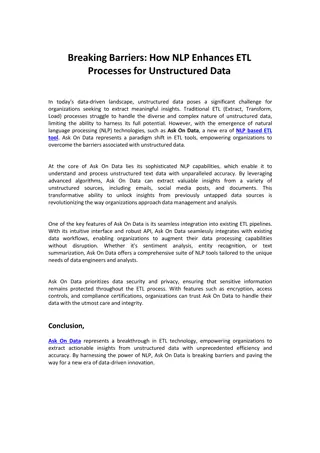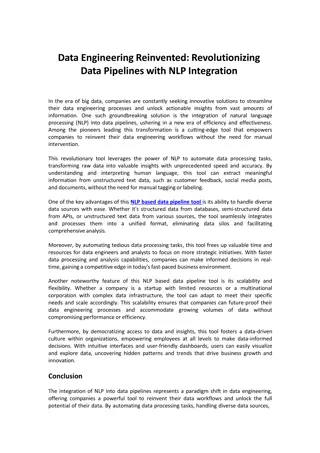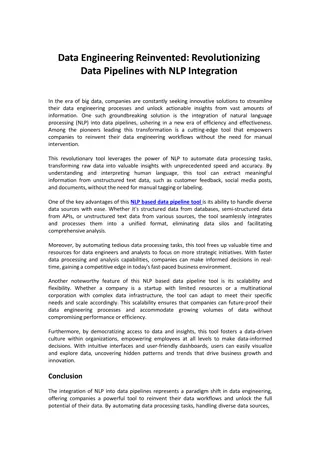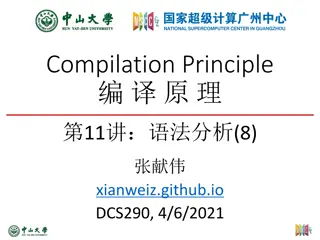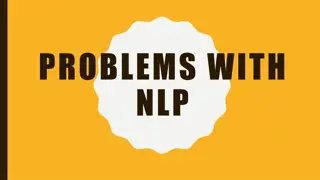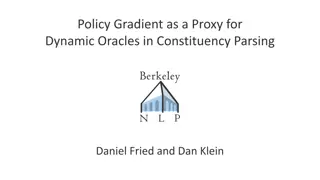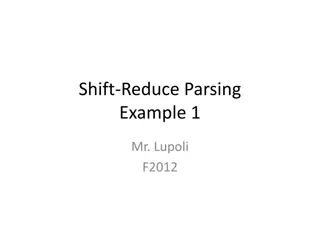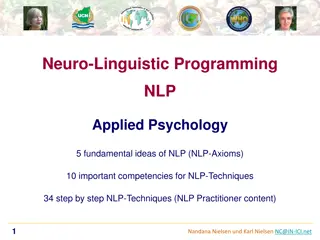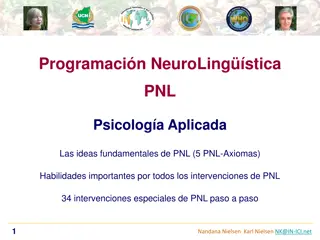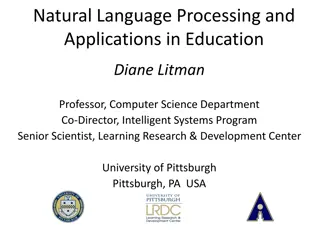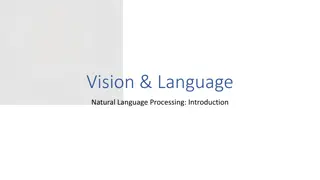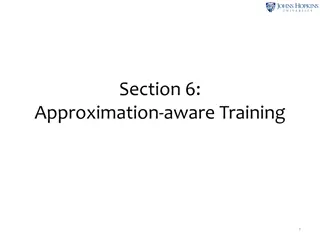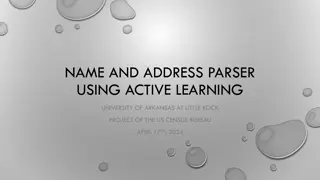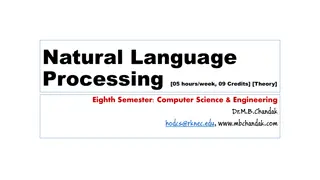Understanding Advanced Parsing Techniques for NLP Evaluation
Delve into the realm of advanced parsing with a focus on evaluating natural language processing models. Learn about tree comparison, evaluation measures like Precision and Recall, and the use of corpora like Penn Treebank for standardized parsing evaluation. Gain insights on how to assess parser performance effectively for improved NLP systems.
Download Presentation

Please find below an Image/Link to download the presentation.
The content on the website is provided AS IS for your information and personal use only. It may not be sold, licensed, or shared on other websites without obtaining consent from the author. Download presentation by click this link. If you encounter any issues during the download, it is possible that the publisher has removed the file from their server.
E N D
Presentation Transcript
ADVANCED PARSING David Kauchak CS159 Fall 2020 some slides adapted from Dan Klein
Admin Assignment 3? Assignment 4 (A and B) Lab next Tuesday
Parsing evaluation You ve constructed a parser You want to know how good it is Ideas?
Parsing evaluation Treebank Train Dev Test Learn a model using the training set Parse the test set without looking at the correct trees Compare our generated parse tree to the correct tree
Comparing trees Correct Tree T S Computed Tree P S VP S VP NP NP PP NP NP PP PRP V N IN N PRP V N IN N I eat sushi with tuna I eat sushi with tuna Ideas?
Comparing trees Idea 1: see if the trees match exactly Problems? Will have a low number of matches (people often disagree) Doesn t take into account getting it almost right Idea 2: compare the constituents
Comparing trees Correct Tree T S Computed Tree P S VP S VP NP NP PP NP NP PP PRP V N IN N PRP V N IN N I eat sushi with tuna I eat sushi with tuna How many constituents match? How can we turn this into a score?
Evaluation measures Precision # of correct constituents # of constituents in the computed tree Recall # of correct constituents # of constituents in the correct tree F1 2 * Precision * Recall What does this favor? Precision + Recall
Comparing trees Correct Tree T S Computed Tree P S VP S VP NP NP PP NP NP PP PRP V N IN N PRP V N IN N I eat sushi with tuna I eat sushi with tuna # Correct Constituents: 9 # Constituents: 11 # Constituents: 10 9/10 0.857 Precision: 9/11 Recall: F1:
Parsing evaluation Corpus: Penn Treebank, WSJ Training: Development: Test: sections section section 02-21 22 (first 20 files) 23 Parsing has been fairly standardized to allow for easy comparison between systems
Treebank PCFGs Use PCFGs for broad coverage parsing Can take a grammar right off the trees (doesn t work well): ROOT S S NP VP . NP PRP VP VBD ADJP .. Model Baseline F1 72.0
Generic PCFG Limitations PCFGs do not use any information about where the current constituent is in the tree PCFGs do not rely on specific words or concepts, only general structural disambiguation is possible (e.g. prefer to attach PPs to Nominals) MLE estimates are not always the best
Conditional Independence? Will a PCFG differentiate between these? What s the problem?
Conditional Independence? It treats all NPs as equivalent but they re not! A grammar with symbols like NP won t be context-free Statistically, conditional independence too strong
Strong independence assumption S S -> NP VP NP -> PRP PRP -> I VP -> V NP V -> eat NP -> N PP N -> sushi PP -> IN N IN -> with N -> tuna VP NP NP PP PRP V N IN N I eat sushi with tuna We re making a strong independence assumption here!
Non-Independence Independence assumptions are often too strong All NPs NPs under S NPs under VP 23% 21% 11% 9% 9% 9% 7% 6% 4% NP PP DT NN PRP NP PP DT NN PRP NP PP DT NN PRP Example: the expansion of an NP is highly dependent on the parent of the NP (i.e., subjects vs. objects). Also: the subject and object expansions are correlated
Grammar Refinement Idea: expand/refine our grammar Challenges: Must refine in ways that facilitate disambiguation Must trade-offs between too little and too much refinement. Too much refinement -> sparsity problems To little -> can t discriminate (PCFG)
Grammar Refinement Ideas?
Grammar Refinement Structure Annotation [Johnson 98, Klein&Manning 03] Differentiate constituents based on their local context Lexicalization [Collins 99, Charniak 00] Differentiate constituents based on the spanned words Constituent splitting [Matsuzaki et al. 05, Petrov et al. 06] Cluster/group words into sub-constituents
Markovization Except for the root node, every node in a parse tree has: A vertical history/context A horizontal history/context S NP VP VBD NP NP Traditional PCFGs use the full horizontal context and a vertical context of 1
Vertical Markovization Vertical Markov order: rewrites depend on past k ancestor nodes. Order 1 is most common: aka parent annotation Order 1 Order 2
Vertical Markovization 79% 25000 78% 20000 77% Symbols 15000 76% 75% 10000 74% 5000 73% 0 72% 1 2v 2 3v 3 1 2v 2 3v 3 Vertical Markov Order Vertical Markov Order F1 performance # of non-terminals
Horizontal Markovization Horizontal Markov order: rewrites depend on past k sibling nodes Order 1 is most common: condition on a single sibling Order Order 1
Horizontal Markovization 74% 12000 73% 9000 Symbols 6000 72% 3000 71% 0 70% 0 1 2v 2 inf 0 1 2v 2 inf Horizontal Markov Order Horizontal Markov Order F1 performance # of non-terminals
Problems with PCFGs What s different between basic PCFG scores here?
Example of Importance of Lexicalization A general preference for attaching PPs to NPs rather than VPs can be learned by an ordinary PCFG But the desired preference can depend on specific words S S NP VP NP VP John V NP John V NP PP put the dog in the carrier put the dog in the carrier Which is correct?
Example of Importance of Lexicalization A general preference for attaching PPs to NPs rather than VPs can be learned by an ordinary PCFG But the desired preference can depend on specific words S S NP VP NP VP John V NP John V NP PP knew the dog in the carrier knew the dog in the carrier Which is correct?
Lexicalized Trees How could we lexicalize the grammar/tree?
Lexicalized Trees Add headwords to each phrasal node Syntactic vs. semantic heads Headship not in (most) treebanks Usually use head rules, e.g.: NP: Take leftmost NP Take rightmost N* Take rightmost JJ Take right child VP: Take leftmost VB* Take leftmost VP Take left child
Lexicalized PCFGs? Problem: we now have to estimate probabilities like VP(put) VBD(put)NP(dog) PP(in) How would we estimate the probability of this rule? Count(VP(put) VBD(put) NP(dog) PP(in)) Count(VP (put)) Never going to get these automatically off of a treebank Ideas?
One approach Combine this with some of the markovization techniques we saw Collins (1999) parser Models productions based on context to the left and the right of the head child. LHS LnLn 1 L1H R1 Rm 1Rm
One approach LHS LnLn 1 L1H R1 Rm 1Rm First generate the head (H) given the parent Then repeatedly generate left symbols (Li) until the beginning is reached Then right (Ri) symbols until the end is reached
Sample Production Generation VPput VBDputNPdog PPin VPput
Sample Production Generation VPput VBDputNPdog PPin VPput VBDput H PH(VBD | VPput)
Sample Production Generation VPput VBDputNPdog PPin VPput STOP VBDput L1 H PL(STOP | VPput)
Sample Production Generation VPput VBDputNPdog PPin VPput STOP VBDput NPdog L1 H R1 PR(NPdog | VPput)
Sample Production Generation VPput VBDputNPdog PPin VPput STOP VBDput NPdog PPin L1 H R1 R2 PR(PPin | VPput)
Sample Production Generation VPput VBDputNPdog PPin VPput STOP VBDput NPdog PPin STOP R3 L1 H R1 R2 PR(STOP | PPin)
Sample Production Generation Note: Penn treebank tends to have fairly flat parse trees that produce long productions. VPput VBDputNPdog PPin VPput STOP VBDput NPdog PPin STOP R3 L1 H R1 R2 PL(STOP | VPput) * PH(VBD | VPput)* PR(NPdog | VPput)* PR(PPin | VPput) * PR(STOP | PPin)
Estimating Production Generation Parameters Estimate PH, PL, and PR parameters from treebank data Count(PPin right of head in a VPput production) PR(PPin | VPput) = Count(symbol right of head in a VPput) Count(NPdog right of head in a VPput production) PR(NPdog | VPput) = Count(symbol right of head in a VPput) Smooth estimates by combining with simpler models conditioned on just POS tag or no lexical info smPR(PPin | VPput-) = 1 PR(PPin | VPput) + (1 1) ( 2 PR(PPin | VPVBD) + (1 2) PR(PPin | VP))
Problems with lexicalization We ve solved the estimation problem There s also the issue of performance Lexicalization causes the size of the number of grammar rules to explode! Our parsing algorithms take too long too finish Ideas?
Pruning during search We can no longer keep all possible parses around We can no longer guarantee that we actually return the most likely parse Beam search [Collins 99] In each cell only keep the K most likely hypotheses Disregard constituents over certain spans (e.g. punctuation) F1 of 88.6!
Pruning with a PCFG The Charniak parser prunes using a two-pass approach [Charniak 97+] First, parse with the base (non-lexicalized) grammar For each X:[i,j] calculate P(X|i,j,s) This isn t trivial, and there are clever speed ups Second, do the fullCKY Skip any X :[i,j] which had low (say, < 0.0001) posterior Avoids almost all work in the second phase! F1 of 89.7!
Final Results F1 F1 40 words all words Parser 86.3 85.7 Klein & Manning 03 86.7 86.1 Matsuzaki et al. 05 88.6 88.2 Collins 99 90.1 89.6 Charniak & Johnson 05 Petrov et. al. 06 90.2 89.7
Human Parsing How do humans do it? How might you try and figure it out computationally/experimentally?
Human Parsing Read these sentences Which one was fastest/slowest? John put the dog in the pen with a lock. John carried the dog in the pen with a bone in the car. John liked the dog in the pen with a bone.
Human Parsing Computational parsers can be used to predict human reading time as measured by tracking the time taken to read each word in a sentence. Psycholinguistic studies show that words that are more probable given the preceding lexical and syntactic context are read faster. John put the dog in the pen with a lock. John carried the dog in the pen with a bone in the car. John liked the dog in the pen with a bone. Modeling these effects requires an incremental statistical parser that incorporates one word at a time into a continuously growing parse tree.
Garden Path Sentences People are confused by sentences that seem to have a particular syntactic structure but then suddenly violate this structure, so the listener is lead down the garden path . The horse raced past the barn fell. vs. The horse raced past the barn broke his leg. The complex houses married students. The old man the sea. While Anna dressed the baby spit up on the bed. Incremental computational parsers can try to predict and explain the problems encountered parsing such sentences.
More garden sentences http://www.fun-with-words.com/ambiguous_garden_path.html The prime number few. Fat people eat accumulates. The cotton clothing is usually made of grows in Mississippi. Until the police arrest the drug dealers control the street. The man who hunts ducks out on weekends. When Fred eats food gets thrown. Mary gave the child the dog bit a bandaid. The girl told the story cried. I convinced her children are noisy. Helen is expecting tomorrow to be a bad day. The horse raced past the barn fell. I know the words to that song about the queen don't rhyme. She told me a little white lie will come back to haunt me. The dog that I had really loved bones. That Jill is never here hurts. The man who whistles tunes pianos. The old man the boat. Have the students who failed the exam take the supplementary. The raft floated down the river sank. We painted the wall with cracks. The tycoon sold the offshore oil tracts for a lot of money wanted to kill JR.



